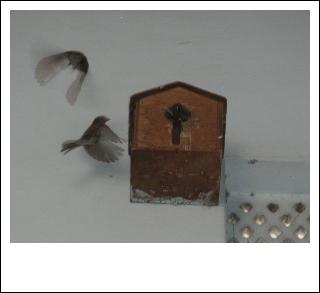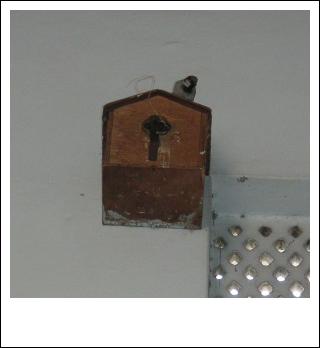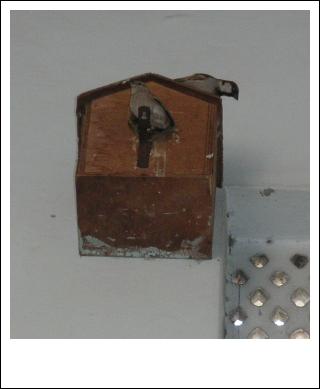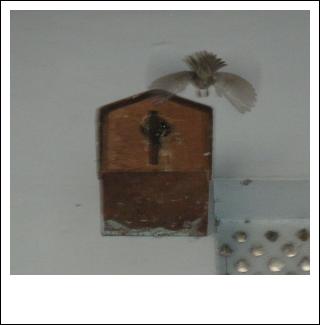hints, allegations and things left unsaid...
Sparrows in my room
As a child I was enamored by my Mother’s compassion and love for animals. I vaguely remember how poorly constructed our house was when we had moved in it some 20 years ago. The roof above all rooms was a rather primitive structure, comprised of concrete slabs supported on thick horizontal planks of wood that in turn were mounted on the four walls of the room breadth wise. There would be tiny creeks between these wooden beams and the concrete slabs, which would encourage sparrows to fly in and peck at the (often termite infested) wood so as to carve a niche that they would then try to stuff with straw. This would go on for a few days, after which their gatherings would fall down for want of more room and their sheer weight. Mom would often fetch a small cutlery holder or steel cups and plant them firmly in their small niche, inside which these birds would slyly construct their nests. Unfortunately Dad did not share the same enthusiasm for cohabiting with sparrows and that often lead to discords when he came back from work in the evening; though ultimately he would have to relent to Mom’s persuasiveness and sparrows’ resilience.
The condition of our house deteriorated with every passing year owing to its shabby construction and things eventually came to a point when we had to get it reconstructed. This was no mean feat as everything had to be flattened to ground and we had to find alternate accommodation for the duration that the construction lasted. We moved into our unfurnished ‘new’ house 4 months later and shortly began carpentry work. Mom ensured that every tiny plank of spare wood was used in construction of small “cuckoo clock” houses where sparrows could roost. About 5 of them were suspended under our terrace ledge and within days they were (and still are) abodes to flourishing families of sparrows.
In our new house, I got my own room (it was a big deal then!). The curtains in my room were mounted on drapery rods fitted under quaint boxy wooden pelmets, atop which I had placed a small card-board painting, inclined against the wall. The little hole between the slanted painting and the wall soon attracted an enterprising couple of sparrows. For large part of the day, this couple would fiercely battle their reflection in the mirror in our verandah (owning to which it would have to be covered with newspapers) and for remaining part, they would toil on their nest in my room; behind the painting on the pelmet. In the evenings, the female would sleep inside the nest while the male would ensconce itself snugly under the pelmet.
One day, as I switched on the light in my room, I was greeted by a sound that was reminiscent of dozens of little anklets stirring together. The chicks had hatched inside the nest! Before I could even gather my senses the female hopped out of the nest and started chirping what sounded like an angry retort for having intruded on their privacy. For next few days, my table lamp was the only source of light in my room.
March flew past and April heralded the beginning of summers. I would still sleep in my room without turning the fan on lest the sparrows should get hurt but as it got hotter I eventually had to retreat to my sister’s room. The chicks had grown larger (and bolder) and often sneaked out of their nests when their parents brought them food. I must confess that their visage was a tad repulsive in their early days as they were yet to sprout feathers.
As they started resembling mature members of their species, the male sparrow would spend extended periods just outside my room teaching them to chirp. These lessons in speech are rather amusing to observe. The male contrives the sweetest of tweets you can attribute to a male sparrow (male sparrows are relatively raucous otherwise) and will wait patiently for the chicks to acknowledge his soliloquy. The chicks chime in chorus and this exchange goes on for minutes at stretch, after which their feeding resumes.
After about 45 days the chicks would be ready to fly off. This used to be an emotional and tense moment for us. Our verandah is fully covered except for this 5 feet x 3 feet railing that was placed to allow light and fresh air. While the sparrows would negotiate the gaps in the railing effortlessly, their chicks were ill equipped with maneuver needed to pass through. The chicks would almost always hatch in groups of three, of which the two would almost always make it to the terrace smoothly. The third, usually the timid one of the lot, would need help. One day we would wake up in the morning to hear faint chirping from under our bed or in the kitchen – one of the chicks, having failed at the attempts to join its siblings, would sit their exhausted. Above, its distressed parents would perch, chirping feverishly. Eventually, mom would have to lift it up in her palms and take it to the terrace for a successful reunion with its anxious parents. We would all heave a sigh of relief and celebrate the happenings of the early morning with a grand breakfast.
As I sat writing this piece, I felt inundated with other childhood memories spanning my days with sparrows (almost all of them worth mentioning on my blog) but for now I conclude with pictures I took on my recent visit home early this month:




For the discerning reader: A quick lesson in ornithology - Sparrows and their habits: The common house sparrow is one of the most common species of birds you will spot in urban India. The male and female can be easily distinguished by their appearance – the male is light grey in color and sports prominent black “beard” like plumage over its neck and breast, while females are streaked, light brown in color. Sparrows feed on different kinds of seeds and grains but also devour most common insects with equal fervor; especially when they are bringing their chicks up. In many big cities, their numbers are declining alarmingly – a trend attributed partly to pollution and partly to modern styles of construction which deprive these little birds of nooks and niches that are so essential to allow them to roost.
As a child I was enamored by my Mother’s compassion and love for animals. I vaguely remember how poorly constructed our house was when we had moved in it some 20 years ago. The roof above all rooms was a rather primitive structure, comprised of concrete slabs supported on thick horizontal planks of wood that in turn were mounted on the four walls of the room breadth wise. There would be tiny creeks between these wooden beams and the concrete slabs, which would encourage sparrows to fly in and peck at the (often termite infested) wood so as to carve a niche that they would then try to stuff with straw. This would go on for a few days, after which their gatherings would fall down for want of more room and their sheer weight. Mom would often fetch a small cutlery holder or steel cups and plant them firmly in their small niche, inside which these birds would slyly construct their nests. Unfortunately Dad did not share the same enthusiasm for cohabiting with sparrows and that often lead to discords when he came back from work in the evening; though ultimately he would have to relent to Mom’s persuasiveness and sparrows’ resilience.
The condition of our house deteriorated with every passing year owing to its shabby construction and things eventually came to a point when we had to get it reconstructed. This was no mean feat as everything had to be flattened to ground and we had to find alternate accommodation for the duration that the construction lasted. We moved into our unfurnished ‘new’ house 4 months later and shortly began carpentry work. Mom ensured that every tiny plank of spare wood was used in construction of small “cuckoo clock” houses where sparrows could roost. About 5 of them were suspended under our terrace ledge and within days they were (and still are) abodes to flourishing families of sparrows.
In our new house, I got my own room (it was a big deal then!). The curtains in my room were mounted on drapery rods fitted under quaint boxy wooden pelmets, atop which I had placed a small card-board painting, inclined against the wall. The little hole between the slanted painting and the wall soon attracted an enterprising couple of sparrows. For large part of the day, this couple would fiercely battle their reflection in the mirror in our verandah (owning to which it would have to be covered with newspapers) and for remaining part, they would toil on their nest in my room; behind the painting on the pelmet. In the evenings, the female would sleep inside the nest while the male would ensconce itself snugly under the pelmet.
One day, as I switched on the light in my room, I was greeted by a sound that was reminiscent of dozens of little anklets stirring together. The chicks had hatched inside the nest! Before I could even gather my senses the female hopped out of the nest and started chirping what sounded like an angry retort for having intruded on their privacy. For next few days, my table lamp was the only source of light in my room.
March flew past and April heralded the beginning of summers. I would still sleep in my room without turning the fan on lest the sparrows should get hurt but as it got hotter I eventually had to retreat to my sister’s room. The chicks had grown larger (and bolder) and often sneaked out of their nests when their parents brought them food. I must confess that their visage was a tad repulsive in their early days as they were yet to sprout feathers.
As they started resembling mature members of their species, the male sparrow would spend extended periods just outside my room teaching them to chirp. These lessons in speech are rather amusing to observe. The male contrives the sweetest of tweets you can attribute to a male sparrow (male sparrows are relatively raucous otherwise) and will wait patiently for the chicks to acknowledge his soliloquy. The chicks chime in chorus and this exchange goes on for minutes at stretch, after which their feeding resumes.
After about 45 days the chicks would be ready to fly off. This used to be an emotional and tense moment for us. Our verandah is fully covered except for this 5 feet x 3 feet railing that was placed to allow light and fresh air. While the sparrows would negotiate the gaps in the railing effortlessly, their chicks were ill equipped with maneuver needed to pass through. The chicks would almost always hatch in groups of three, of which the two would almost always make it to the terrace smoothly. The third, usually the timid one of the lot, would need help. One day we would wake up in the morning to hear faint chirping from under our bed or in the kitchen – one of the chicks, having failed at the attempts to join its siblings, would sit their exhausted. Above, its distressed parents would perch, chirping feverishly. Eventually, mom would have to lift it up in her palms and take it to the terrace for a successful reunion with its anxious parents. We would all heave a sigh of relief and celebrate the happenings of the early morning with a grand breakfast.
As I sat writing this piece, I felt inundated with other childhood memories spanning my days with sparrows (almost all of them worth mentioning on my blog) but for now I conclude with pictures I took on my recent visit home early this month:




For the discerning reader: A quick lesson in ornithology - Sparrows and their habits: The common house sparrow is one of the most common species of birds you will spot in urban India. The male and female can be easily distinguished by their appearance – the male is light grey in color and sports prominent black “beard” like plumage over its neck and breast, while females are streaked, light brown in color. Sparrows feed on different kinds of seeds and grains but also devour most common insects with equal fervor; especially when they are bringing their chicks up. In many big cities, their numbers are declining alarmingly – a trend attributed partly to pollution and partly to modern styles of construction which deprive these little birds of nooks and niches that are so essential to allow them to roost.
1 Comments
Thank you, THANK YOU for this sweet (and educational) account. ;)
And most of all, thank you for being capable of loving sparrows.
I do, too, as you can probably guess. I love all animals (but don't "own" any), of course - but house sparrows, these cute and amazingly intelligent - and funny! ;) - little rascals, have been my favourites for many many years.
I hope you have the blessed life that such a person deserves. (And that goes for all of your family, but especially your mother and yourself.)
By , at 19.7.07
Post a Comment
| Archives | Blogroll |
|
May 2003 | June 2003 | July 2003 | August 2003 | September 2003 | October 2003 | November 2003 | December 2003 | January 2004 | February 2004 | March 2004 | April 2004 | May 2004 | June 2004 | July 2004 | August 2004 | September 2004 | October 2004 | November 2004 | December 2004 | January 2005 | February 2005 | March 2005 | April 2005 | May 2005 | June 2005 | July 2005 | August 2005 | September 2005 | October 2005 | November 2005 | December 2005 | January 2006 | February 2006 | March 2006 | Current Posts |
All material posted on this blog is copyrighted and may not be used in any form without the explicit permission of the author.
